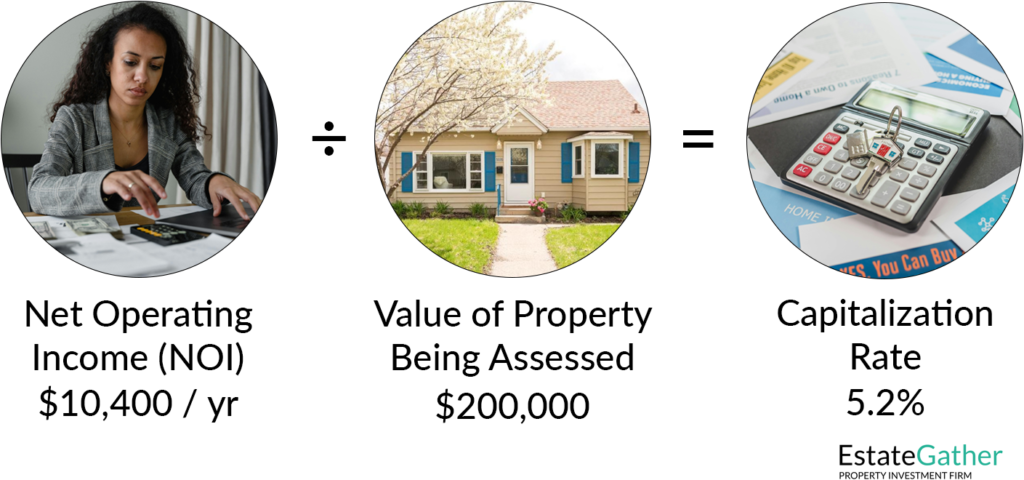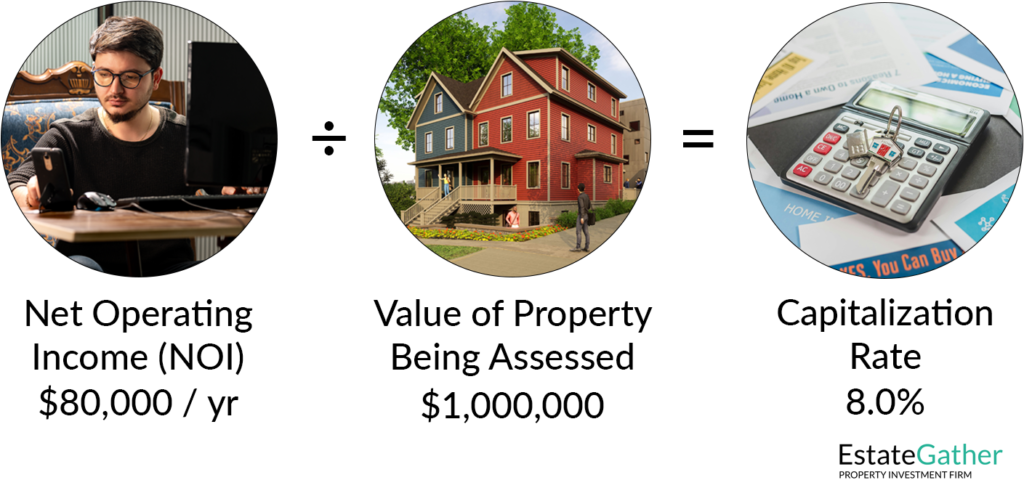Capitalization (CAP) Rate
In the world of real estate investing, there are several key concepts that can greatly impact your decision-making process. One such concept is the Capitalization Rate (Cap Rate). The Cap Rate is a fundamental metric used by investors to evaluate the potential profitability and risk associated with a real estate investment property. In this article, we will break down what the Capitalization Rate is, why it matters, and how to calculate it.
KEY TAKEAWAYS
- Cap Rate Definition and Importance: The Capitalization Rate is an important metric for real estate investors as it quantifies the relationship between a property’s Net Operating Income (NOI) and its market value, providing insight into potential returns relative to the property’s purchase price. It is a fundamental tool for evaluating the profitability and risk associated with an investment property.ㅤ
- Quick Assessment: Cap Rate allows investors to quickly compare different investment properties based on their potential returns. Higher Cap Rates suggest potentially better returns but may also indicate higher risk, while lower Cap Rates imply safer and more stable investments.
- Calculating Cap Rate: Cap Rate is calculated using a straightforward formula: Cap Rate = (Net Operating Income / Property’s Market Value) x 100. Net Operating Income represents the property’s income minus operating expenses (excluding mortgage payments (debt servicing) and income taxes), and the property’s market value is its current fair market price. Cap Rate is a great metric, but it should be used in conjunction with other financial metrics and thorough market research for a coherent investment strategy.
What is Capitalization Rate?
At its core, the Capitalization Rate is a percentage that helps investors assess the potential return on an investment property based on its income. It essentially quantifies the relationship between the property’s net operating income and its market value. It is important to understand that Cap Rate is a measurement of the annual return on investment a property would generate if owned in cash.

Sponsor
YOUR
ADVERTISEMENT
HERE
Just $20 a Month, for full site coverage.

Why Does Capitalization Rate Matter?
The Capitalization Rate serves as a valuable tool for real estate investors for several reasons:
- Quick Assessment of Investment Potential: Cap Rate provides a quick way to compare the potential returns of different investment properties. A 5% Cap Rate means that the property generates a 5% annual return if owned outright in cash. A 10% Cap Rate means the property generates a 10% annual return if owned outright in cash. This is a very quick and simple way to compare investment opportunities. It is important to consider that properties with higher Cap Rates may offer better returns, but they could also come with higher risks.
- Risk Evaluation: A higher Cap Rate often indicates a riskier investment, while a lower Cap Rate signifies a safer and more stable investment. This helps investors match their risk tolerance with the appropriate property. For example, beach front property in Miami would likely have a substantially lower Cap Rate than a trailer park in rural America. The beach front property would be considered lower risk because it is assumed that there will always be demand for people to live on the beach in Miami, while the rural area the trailer park is located in may only have one or two things to offer in order to attract new residents. Additionally, the trailer park itself may have rampant crime or possible infrastructure issues that make the property riskier due to the potential for vandalism or large repair bills in the future.
- Market Insights: Cap Rates can offer insights into the overall health of a real estate market. A rising Cap Rate in a specific market might suggest a potential downturn, while a decreasing Cap Rate could indicate increasing demand and property values. Rising Cap Rates indicate a potential downturn because Cap Rate = Net Operating Income / Property Value. If Cap Rates are rising, then Property Value is either decreasing or rents are rising. While property values decreasing clearly indicate a downturn, even rising rents without a proportional increase in property value indicates a downturn as inflation is required for rising rents, meaning that the property values adjusted for inflation are decreasing.
– Rising Cap Rates: If Cap Rates are on the rise in a specific market, it could be indicative of a potential downturn. This could be due to a variety of factors such as increased vacancy rates, declining rental income, or general economic uncertainty. Investors might interpret rising Cap Rates as a signal that property values might be decreasing or that the market is becoming less favorable for investment.
– Decreasing Cap Rates: Conversely, a decrease in Cap Rates can signal increasing demand for properties in that market. This is often associated with a competitive market where investors are willing to pay a premium for properties due to high demand. As property values increase and rental income grows, the ratio of Net Operating Income to Property Value decreases, leading to a lower Cap Rate.
Sponsor
YOUR
ADVERTISEMENT
HERE
Just $20 a Month, for full site coverage.

Calculating Capitalization Rate
Calculating the Capitalization Rate involves a straightforward formula:
Cap Rate = (Net Operating Income / Property’s Market Value) x 100
- Net Operating Income (NOI): This is the total income generated by the property minus operating expenses, excluding mortgage payments and income taxes. Operating expenses typically include property management fees, maintenance costs, insurance, and property taxes. Mortgage payments are not included because they are financing costs. If your mortgage payment includes property taxes and insurance, the property taxes and insurance would count towards operating expenses but not the payments going towards loan paydown or interest/other related financing costs. The reason for the exclusion of financing costs and taxes are that Cap Rate is calculating your percentage return annually in a world where the property is paid off and you do not pay any taxes.
- Property’s Market Value: The market value of the property is the current fair market price that it could sell for.
Step-by-Step Calculation:
Let’s say you have a property with an annual NOI of $80,000 and a market value of $1,000,000.
Cap Rate = ($80,000 / $1,000,000) x 100 = 8%
In this example, the property has a Cap Rate of 8%.

Capitalization Rate Calculator

Is CapEx included in Cap Rate Calculations?
No, CapEx (capital expenditures) is not included in cap rate calculations. Capital expenditures are not considered operating expenses, because they are infrequent, large-scale costs (like replacing a roof or HVAC), whereas operating expenses are recurring (like property management, insurance, maintenance).
However, some investors use a modified cap rate by subtracting estimated annual CapEx from NOI to be more conservative, especially when comparing older vs. newer properties.
Interpreting the Cap Rate:
Interpreting the Cap Rate involves considering the current market conditions and your investment goals:
- High Cap Rate: A property with a high Cap Rate might seem attractive due to potentially higher returns. However, this could also indicate higher risk, such as a less desirable location or property condition. This could also signal an environment with high interest rates where treasury bonds are yielding high returns or investors are not leveraging their capital as much.
- Low Cap Rate: A lower Cap Rate might suggest a more stable and less risky investment. Properties with lower Cap Rates are often found in prime locations or in markets with high demand. Interest rates may be very low and leverage in the market could be high.
Conclusion
Capitalization Rate is a very useful metric in real estate. It offers a valuable snapshot of the potential return and risk associated with a property, aiding investors in making informed decisions aligned with their goals and risk appetite. By understanding how to calculate and interpret the Cap Rate, you can navigate the complex world of real estate investing with greater confidence and insight. Remember, while the Cap Rate is a crucial factor, it's best used in conjunction with other financial metrics and thorough market research for a well-rounded investment strategy.
Frequently Asked Questions (FAQ)
What is Capitalization Rate?
The Capitalization Rate, or Cap Rate, is a fundamental metric used in real estate to evaluate the potential return on an investment property. It quantifies the relationship between a property’s Net Operating Income (NOI) and its market value, helping investors assess profitability relative to the property’s purchase price.
Why is Cap Rate important in real estate investing?
Cap Rate is crucial because it provides a quick and efficient way to compare the potential returns of different investment properties. It helps investors assess the risk associated with each property; higher Cap Rates generally indicate higher potential returns but also higher risks, while lower Cap Rates suggest more stability and less risk.
How do you calculate the Cap Rate?
Cap Rate= (Net Operating Income (NOI) / Property’s Market Value) × 100
Where:
- Net Operating Income (NOI) is the income from the property minus operating expenses, excluding debt service and income taxes.
- Property’s Market Value is the current fair market price of the property.
Can Cap Rate indicate the quality of an investment?
Yes, Cap Rate can serve as an indicator of investment quality. A higher Cap Rate may suggest a potentially higher return on investment but at a possibly higher risk. Conversely, a lower Cap Rate often indicates a safer, more stable investment, which might be preferable for investors seeking less risk.
What does a high Cap Rate imply?
A high Cap Rate can imply that an investment offers higher potential returns, making it attractive to those willing to take on greater risks. However, it can also suggest that the property is in a less desirable location or has other factors that increase its risk, such as higher vacancy rates or additional maintenance costs.
What does a low Cap Rate imply?
A low Cap Rate typically implies that the property is likely to be a safer, more stable investment. Properties with low Cap Rates are often in high-demand areas or premium locations, which are less likely to experience significant fluctuations in value or rental income.
How can Cap Rate affect real estate investment decisions?
Cap Rate affects investment decisions by providing a clear metric to compare different properties based on their income-generating potential relative to their market value. This allows investors to quickly identify which properties might meet their return expectations and align with their risk tolerance.
What are the limitations of using Cap Rate?
The main limitations of using Cap Rate include:
- It does not account for future changes in income or expenses.
- It excludes the cost of financing and taxes.
- It may not provide a full picture of an investment’s profitability if used alone.
How can changes in the real estate market affect Cap Rate?
Changes in the real estate market can affect Cap Rates through fluctuations in property values and rental incomes. For example, a market downturn can increase Cap Rates if property values fall, whereas a booming market might decrease Cap Rates due to rising property values.

